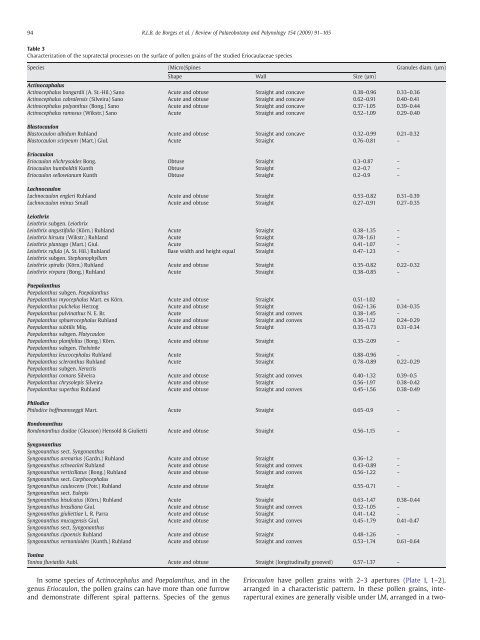Comparative pollen morphology and taxonomic ... - CNCFlora
Comparative pollen morphology and taxonomic ... - CNCFlora
Comparative pollen morphology and taxonomic ... - CNCFlora
You also want an ePaper? Increase the reach of your titles
YUMPU automatically turns print PDFs into web optimized ePapers that Google loves.
94 R.L.B. de Borges et al. / Review of Palaeobotany <strong>and</strong> Palynology 154 (2009) 91–105<br />
Table 3<br />
Characterization of the supratectal processes on the surface of <strong>pollen</strong> grains of the studied Eriocaulaceae species<br />
Species (Micro)Spines Granules diam. (µm)<br />
Shape Wall Size (µm)<br />
Actinocaphalus<br />
Actinocephalus bongardii (A. St.-Hil.) Sano Acute <strong>and</strong> obtuse Straight <strong>and</strong> concave 0.38–0.96 0.33–0.36<br />
Actinocephalus cabralensis (Silveira) Sano Acute <strong>and</strong> obtuse Straight <strong>and</strong> concave 0.62–0.91 0.40–0.41<br />
Actinocephalus polyanthus (Bong.) Sano Acute <strong>and</strong> obtuse Straight <strong>and</strong> concave 0.37–1.05 0.39–0.44<br />
Actinocephalus ramosus (Wikstr.) Sano Acute Straight <strong>and</strong> concave 0.52–1.09 0.29–0.40<br />
Blastocaulon<br />
Blastocaulon albidum Ruhl<strong>and</strong> Acute <strong>and</strong> obtuse Straight <strong>and</strong> concave 0.32–0.99 0.21–0.32<br />
Blastocaulon scirpeum (Mart.) Giul. Acute Straight 0.76–0.81 –<br />
Eriocaulon<br />
Eriocaulon elichrysoides Bong. Obtuse Straight 0.3–0.87 –<br />
Eriocaulon humboldtii Kunth Obtuse Straight 0.2–0.7 –<br />
Eriocaulon sellowianum Kunth Obtuse Straight 0.2–0.9 –<br />
Lachnocaulon<br />
Lachnocaulon engleri Ruhl<strong>and</strong> Acute <strong>and</strong> obtuse Straight 0.53–0.82 0.31–0.39<br />
Lachnocaulon minus Small Acute <strong>and</strong> obtuse Straight 0.27–0.91 0.27–0.35<br />
Leiothrix<br />
Leiothrix subgen. Leiothrix<br />
Leiothrix angustifolia (Körn.) Ruhl<strong>and</strong> Acute Straight 0.38–1.35 –<br />
Leiothrix hirsuta (Wikstr.) Ruhl<strong>and</strong> Acute Straight 0.78–1.61 –<br />
Leiothrix plantago (Mart.) Giul. Acute Straight 0.41–1.07 –<br />
Leiothrix rufula (A. St. Hil.) Ruhl<strong>and</strong> Base width <strong>and</strong> height equal Straight 0.47–1.23 –<br />
Leiothrix subgen. Stephanophyllum<br />
Leiothrix spiralis (Körn.) Ruhl<strong>and</strong> Acute <strong>and</strong> obtuse Straight 0.35–0.82 0.22–0.32<br />
Leiothrix vivpara (Bong.) Ruhl<strong>and</strong> Acute Straight 0.38–0.85 –<br />
Paepalanthus<br />
Paepalanthus subgen. Paepalanthus<br />
Paepalanthus myocephalus Mart. ex Körn. Acute <strong>and</strong> obtuse Straight 0.51–1.02 –<br />
Paepalanthus pulchelus Herzog Acute <strong>and</strong> obtuse Straight 0.62–1.36 0.34–0.35<br />
Paepalanthus pulvinathus N. E. Br. Acute Straight <strong>and</strong> convex 0.38–1.45 –<br />
Paepalanthus sphaerocephalus Ruhl<strong>and</strong> Acute <strong>and</strong> obtuse Straight <strong>and</strong> convex 0.36–1.12 0.24–0.29<br />
Paepalanthus subtilis Miq. Acute <strong>and</strong> obtuse Straight 0.35–0.73 0.31–0.34<br />
Paepalanthus subgen. Platycaulon<br />
Paepalanthus planifolius (Bong.) Körn. Acute <strong>and</strong> obtuse Straight 0.35–2.09 –<br />
Paepalanthus subgen. Thelxinöe<br />
Paepalanthus leucocephalus Ruhl<strong>and</strong> Acute Straight 0.88–0.96 –<br />
Paepalanthus scleranthus Ruhl<strong>and</strong> Acute Straight 0.78–0.89 0.22–0.29<br />
Paepalanthus subgen. Xeractis<br />
Paepalanthus comans Silveira Acute <strong>and</strong> obtuse Straight <strong>and</strong> convex 0.40–1.32 0.39–0.5<br />
Paepalanthus chrysolepis Silveira Acute <strong>and</strong> obtuse Straight 0.56–1.97 0.38–0.42<br />
Paepalanthus superbus Ruhl<strong>and</strong> Acute <strong>and</strong> obtuse Straight <strong>and</strong> convex 0.45–1.56 0.38–0.49<br />
Philodice<br />
Philodice hoffmannseggii Mart. Acute Straight 0.65–0.9 –<br />
Rondonanthus<br />
Rondonanthus duidae (Gleason) Hensold & Giulietti Acute <strong>and</strong> obtuse Straight 0.56–1.15 –<br />
Syngonanthus<br />
Syngonanthus sect. Syngonanthus<br />
Syngonanthus arenarius (Gardn.) Ruhl<strong>and</strong> Acute <strong>and</strong> obtuse Straight 0.36–1.2 –<br />
Syngonanthus schwackei Ruhl<strong>and</strong> Acute <strong>and</strong> obtuse Straight <strong>and</strong> convex 0.43–0.89 –<br />
Syngonanthus verticillatus (Bong.) Ruhl<strong>and</strong> Acute <strong>and</strong> obtuse Straight <strong>and</strong> convex 0.56–1.22 –<br />
Syngonanthus sect. Carphocephalus<br />
Syngonanthus caulescens (Poir.) Ruhl<strong>and</strong> Acute <strong>and</strong> obtuse Straight 0.55–0.71 –<br />
Syngonanthus sect. Eulepis<br />
Syngonanthus bisulcatus (Körn.) Ruhl<strong>and</strong> Acute Straight 0.63–1.47 0.38–0.44<br />
Syngonanthus brasiliana Giul. Acute <strong>and</strong> obtuse Straight <strong>and</strong> convex 0.32–1.05 –<br />
Syngonanthus giuliettiae L. R. Parra Acute <strong>and</strong> obtuse Straight 0.41–1.42 –<br />
Syngonanthus mucugensis Giul. Acute <strong>and</strong> obtuse Straight <strong>and</strong> convex 0.45–1.79 0.41–0.47<br />
Syngonanthus sect. Syngonanthus<br />
Syngonanthus cipoensis Ruhl<strong>and</strong> Acute <strong>and</strong> obtuse Straight 0.48–1.26 –<br />
Syngonanthus vernonioides (Kunth.) Ruhl<strong>and</strong> Acute <strong>and</strong> obtuse Straight <strong>and</strong> convex 0.53–1.74 0.61–0.64<br />
Tonina<br />
Tonina fluviatilis Aubl. Acute <strong>and</strong> obtuse Straight (longitudinally grooved) 0.57–1.37 –<br />
In some species of Actinocephalus <strong>and</strong> Paepalanthus, <strong>and</strong>inthe<br />
genus Eriocaulon, the <strong>pollen</strong> grains can have more than one furrow<br />
<strong>and</strong> demonstrate different spiral patterns. Species of the genus<br />
Eriocaulon have <strong>pollen</strong> grains with 2–3 apertures (Plate I, 1–2),<br />
arranged in a characteristic pattern. In these <strong>pollen</strong> grains, interapertural<br />
exines are generally visible under LM, arranged in a two-
















